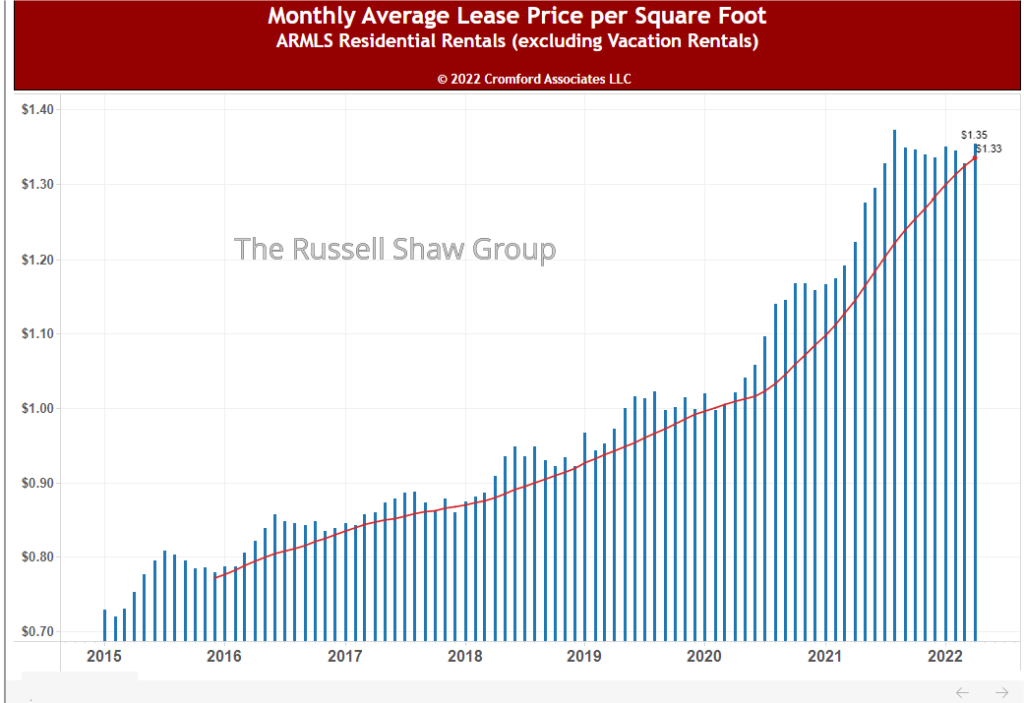Gary Keller …The current market is ‘the most confusing I’ve ever seen…
There’s a lot to worry about in today’s market — coronavirus infections are near 2021 peaks, health officials are ringing the alarm about monkeypox and polio, inflation and mortgage rates are steadily climbing, home sales have slowed and the industry’s biggest real estate companies are bracing for a possible recession.
Even as strengthening headwinds pushing agents and consumers to the brink, Keller Williams founder Gary Keller encouraged agents at the brokerage’s annual Mega Camp conference on Tuesday to take a more tempered approach to analyzing the current market.
“When times are good, understand at some point, they’ll get tougher,” he said matter of factly while sporting a black graphic tee that read ‘Charge the storm.’ “And when times are tougher, at some point, they’ll get good. That’s just the way the world works.”
However, Keller couldn’t help but acknowledge that today’s market shift is much different than past cycles when it was easier to read the tea leaves and understand exactly what to do to survive. However, he said today’s market is filled with ‘mixed signals’ that can make it hard to strategize.
“I would say this is the most confusing market I’ve ever seen in my entire 40-plus years in our industry. It’s confusing, and it’s only confusing because you have mixed signals,” he said. “Normally, you would expect all the signals to aim in one direction. And that’s not what’s happening.”
Keller noted that although home prices are rising, average days on market are still at an all-time low, despite being longer than two to three-day timeline agents got used to at the height of the pandemic. He also highlighted the false alarm around rising mortgage rates, which, despite hovering near six percent, are also near historic lows.
“If you’re talking to individuals that don’t understand mortgage rates, they do not realize that 2.9 percent was a gift from the gods maybe never to be seen again in your lifetime,” he said of the past two years’ trends. “But a lot of people remember, again, that when I got in real estate, and interest rates were below 10 percent. That was considered amazing.”
“Then they rose to almost 18 percent, and I remember all of these experienced agents in the office where I worked — they all went, ‘Nobody’s gonna buy real estate at these rates, we’re just gonna sit and wait for it to come back,” he added. “I don’t think they lasted in the industry. Right?”
Keller directed agents to be attuned to the market, but resist falling into the belief their businesses can’t continue to thrive even in such confusing times.
“I ignored the market and kept doing my activities,” he said hearkening back to his first years in the business,” he added. “I just kept going on about my activities, and there were four or five months where I actually didn’t have any closings… And by the end of the year, I hit every financial goal I set for myself and I even took December off.”
“The trick was ignoring the market and keep doing the activities,” he added. “That’s where you’ve got to be real careful because some of you will see this data and go ‘Oh crud, things really suck. The sky is falling and I can’t do any better.’ Don’t fall into that trap.”
Home sales are slowing — but don’t freak out
In 2020 and 2021, agents easily smashed their previous sales records as rock-bottom mortgage rates, remote working, a pause on student loan payments and several stimulus checks pushed buyers to battle each other for scant listings. However, 2022 ushered in a slower pace as inflation, rising mortgage rates and other socio-economic factors tempered buyers’ ravenous appetite for homebuying.
As a result, Keller said the industry will end the year with 5.1 million home sales, which falls in line with other predictions that place year-end sales around the 5.7 million mark. Although 5.1 million is a far cry from 2021’s 6.1 million home sales, Keller said that’s still a healthy number of transactions compared to the early 90s when annual home sales struggled to break four million.
“If you look at 5.1 and you go all the way back to 1995, 5.1 [million] looks pretty darn good, so perspective really matters,” he said. “There’s plenty of real estate being bought and sold to build fantastic businesses and have fantastic income around that business.
So why does the current market feel more like a drought than a monsoon of opportunity? Keller Williams Vice President of Strategic Content Jay Papasan said it comes down to one thing: more competition.
“The last time we were at 5 million [transactions] there was a third of the Realtors that there are today,” he said. “So there’s just more people chasing the same transactions.”
With that in mind, Keller and Papasan said agents need to focus on mastering the fundamentals of real estate and focus on becoming better at handling hard times rather than wishing for easier ones.
“When interest rates went to almost 18 percent and the transactions really dropped off dramatically, my attitude every day was somebody’s going to buy or sell a house and I’m gonna go work with them,” he added. “Everybody else? Good luck.”
Slowing home price growth ≠ buyers’ market
Rising home price growth has been the bane of homebuyers’ existence for the past seven years, as homebuilders struggled to fix a worsening imbalance between supply and demand.
That imbalance has worsened over the past two years as coronavirus-induced supply chain issues and rising labor and material costs slowed builders, and market headwinds encouraged a record-level of buyers to enter the market. As a result, home prices have continued their meteoric rise with national home price growth reaching around 18 percent in 2021, which Keller Williams Senior Economist Ruben Gonzalez won’t last for long.
“For some perspective, the last time we had a double-digit price increase, that was followed by seven years of single-digit price increases,” he said. “So having multiple years of double-digits is very unusual and it’s not something that’s going to persist.”
Before homebuyers pull out their bullhorns in celebration, Gonzalez and Keller said a slow down in home price growth doesn’t necessarily mean homes will become more affordable.
“We don’t believe we’re going to see negative price [appreciation],” Keller explained while noting it’ll take at least four years for the market to reach the historic trendline of 4 percent home price growth. “We believe that we will simply see a reduction in the rate of inflation [for home prices].”
Keller said homebuyers are currently spending 25 percent of their income on housing costs, which albeit high, is still lower than previous decades when homebuyers spent up to 35 percent of their monthly income on a mortgage.
“I’m so oriented towards my days of selling, that I go, ‘Yeah, what’s the big deal?’ Keller admitted. “Because in 1979, which isn’t on this chart, in 1979, I promise you that number was 32 to 35 percent and I thought that was normal.”
Keller said inventory is still at 3.3 months, which signals sellers still have the upper hand. However, if the United States market follows Canada, a true buyers market could be on the way.
“The reality is that what we just came out of — and I can’t say it enough — is unprecedented. And people are going to have to forget that. That was [about making hay when the sun shines,” he said. “Canada is experiencing exactly what the US is experiencing.”
“Sales are dropping at about the same pace, price appreciation a little less than what we’re gonna experience this year, but almost right in line with that, and inventory? Same thing,” he added. “They’re moving into a buyers market rapidly.”
Inflation is taking the gas out of people’s tanks — literally and figuratively
Although the past two years have been heartbreaking, Keller said there’s still been plenty of opportunities as evidenced by record-low unemployment rates, robust home sales (until now), and relatively solid personal finances among homebuyers compared to the Great Recession.
However, consumer sentiment is at a record low. Why? Inflation.
“There is more money sitting out there in bank accounts than ever before. People are unemployed at one of the lowest rates in history and son-of-a-b — they’re unhappy. Desperately unhappy,” he said. “It’s just a little weird, right? You’ve got a job. You’re just got a great pay raise. You’re living a good life.”
“I truly believe that gas is the number one determinant of how consumers feel about the economy, and the reason is an extra $100 to $200 a month just on gas, is the extra money — that’s new clothes for the kids to go to school. That’s just that extra money for that, that three-day or four-day vacation trip,” he said. “It takes some of the little fun out of it.”
Keller said it’s important for agents to help consumers properly process economic stressors, which will help them make better financially-sound decisions about homebuying and selling.
“It’s going to take through 2023, most likely, to grind through all of this,” he said. “But the last three years have misled people to believe that buying real estate was like owning an ATM. “Yeah, I can buy it and tomorrow, I’ll just flip it.’ This real estate game is amazing, but that was a moment in time. That’s not reality.”
Keller said agents must help homebuyers think about real estate in the long-term and that any
purchase that’s made with the intent of staying seven years or more, is a winning decision even in this market.
“If your holding horizon is anywhere from seven to 10 years, the facts show that you’re good to go,” he said. “Someone says, ‘Oh, you know, I don’t want to buy right now. I’m afraid prices go lower.’ Well, institutional buyers are seizing opportunities.”
“I remember reading the books when it was really hot and heavy about buying versus renting, and the investment world was saying buying a home is never good,” he added. “Call Blackstone and all the other institutional investors and say ‘You shouldn’t buy.’”
“But ultimately it’s not your life, it’s their life, and your goal is to give them the perspective and give them every chance to understand all the issues so they can make an informed decision.”
Even through the confusion of today’s market, Keller said agents can still create some of the best years of their careers if they’re willing to charge into the storm instead of running from it.
“Buffaloes are an interesting animal. When a storm occurs, they’re the singular animal that runs into the storm. Somehow they figured out that if you face the storm and run into it, you get through it better and faster,” he said. “That’s how you win.”


